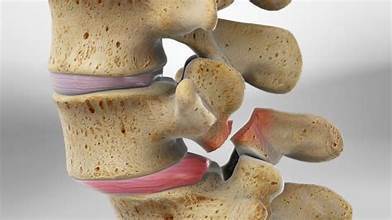
Imagine you’re a 16-year-old athlete in immense lower back pain and you get imaging only for a doctor to tell you that you broke your back. I’m sure you have a million questions with not many helpful answers given. Just rest isn’t helping and you’re not sure what is causing your lower back pain. These three terms sound confusing but they are simple when you break them down.
Spondylosis refers to degenerative osteoarthritis (OA) of the spine- meaning the space between your vertebrae becomes smaller as the protective cartilage that cushions the ends of the vertebrae wears down with age. However, Spondylolysis and spondylolisthesis are considered the most common causes of persistent low back pain in children in adolescents. Symptoms are more likely to be felt during times of rapid skeletal growth or increased physical activity.
Spondylolysis refers to a stress fracture defect in the pars interarticularis of the vertebrae (mostly found in the L4/L5 region) due to repetitive stress or trauma. Symptoms may or may not be present initially, but as the injury progresses, the person may complain of bending backward or combinations of excessive twisting/rotating.
Spondylolisthesis refers to the progression of a spondylosis injury, but it may also be congenital or idiopathic. Spondylolisthesis is defined as the displacement of one vertebra over the vertebral body below it (commonly referred to as a “slip” at the L5/S1 level). There are 5 different grades of this slippage, and it’s defined by the extent to which the vertebral body has slipped:
Grade I: O-25% Grade III: 50-75% Grade V: > 100%
Grade II: 25-50% Grade IV: 75-100%
Referral to an orthopedic spine specialist is a consideration for high-grade spondylolisthesis (Grade 3 and above) or more complicated cases; however, the majority of patients don’t fit this category, and a trial of care for 8-12 weeks is recommended.
At Strength & Spine Chiropractic, we commonly refer to terms like stability and mobility regarding your injury and this is no different. Typically the injured area is begging for stability and this comes in the form of targeted specific rehab-focused exercises on strengthening the function around your lower back. Spinal Manipulation has been shown to be an effective tool for pain when applied at the segments above and below the instability and this has been shown to help with temporary pain and range of motion. This is why we don’t just “crack” you where you hurt as this could worsen the problem and it is a lazy assessment and treatment. Other treatments like Winback Tecar Therapy and other soft tissue applications can effectively improve acute symptomatic cases early on in treatment.
One of the best treatments for this is educating the patient on what is going on and why. As part of our motto of being WISER. Stronger. Better. Most people can be scared about never playing their respective sport, lifting weights, or just being pain-free later in their lives. It should be important to you to work with someone who understands these injuries and knows how to guide you through the process of how to manage your low back not just now but in the future.
If you are looking for a unique solution to managing your lower back pain and helping you
return to doing what you love, give us a call today at 727-228-3030 or schedule an
appointment online at strengthchiro.com
.jpg)
.jpg)
